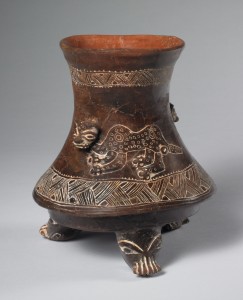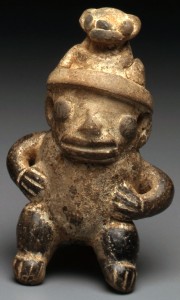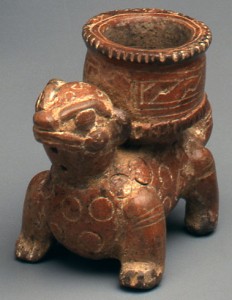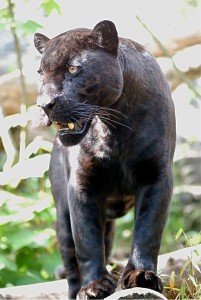Tawny jaguars with black rosettes may be the most familiar, and black-on-black felines the most mysterious, but those with black spots on a chocolate or cinnamon brown pelt also merited artistic illustration in ancient Costa Rica. The brown jaguar was intentionally evoked by painting with the appropriate color slip (clay paint), an unusual artistic choice.

Tripod Vessel with Modeled and Incised Brown Jaguar Motifs Central America, Costa Rica, Greater Nicoya. Belen Incised, Belen Variety. Period V-Period VI, 700-1350 AD. Ceramic. 1991.4.312. Ex coll. William C. and Carol W. Thibadeau. Photo by Bruce M. White, 2008.
Like images of the tawny and black jaguars, the human and the brown jaguar were combined to show that a powerful shaman had assumed animal attributes during trance. Although their bodies are obviously feline, the two figures clearly have almond-shaped human eyes (jaguars’ are rounder and the inner points lower than the outer ones). According to the oval shape under the tail, these transformed shamans are female, as often is the case in ancient Central American cultures. Another reason to show chocolate jaguars as fertile females is that dark mothers can give birth to any color cub (dark coloration is genetically dominant). This special generative talent would lend further prestige to a shaman with a brown jaguar animal self.

Flute in the Form of a Shaman with a Brown Jaguar on Head Central America, Greater Nicoya, Costa Rica. Marbella Incised. Period IV, 300 BC – 500 AD. Ceramic. 1991.4.309. Ex coll. William C. and Carol W. Thibadeau. Photo by Michael McKelvey.
The diminutive figurine is male but assumes the typical womanly pose with hands holding a bulging belly. His brown jaguar self appears on the fontanel, the crown of the head, a typical placement in shamanic imagery. The fontanel remains soft (the bones of the skull not yet knit) for a year or two after a baby’s birth and thus in shamanism represents where life force and expanded consciousness enter throughout life. Here the juxtaposition indicates that this powerful shaman becomes a brown jaguar in his visions.

Brown Jaguar with Earspool on Back Central America, Greater Nicoya, Costa Rica. Guinea Incised. Period IV, 300 BC- 500 AD. Ceramic. 1991.4.579. Ex coll. William C. and Carol W. Thibadeau. Photo by Michael McKelvey.
The power and prestige of the dark jaguar are reiterated in a spotted cinnamon feline carrying an oversized earspool (like a modern “gauge”) worn in ancient Costa Rica. The larger the earspools’ diameter, the older and more high-status the wearer, whose lobes had to stretch gradually over the years. Life expectancy was low in ancient times, so wearing large earspools indicated victory over death and hence healing powers suitable for a shaman. Here the brown jaguar paired with the large earring shows a shaman with this animal self who was a dominant individual in society.
